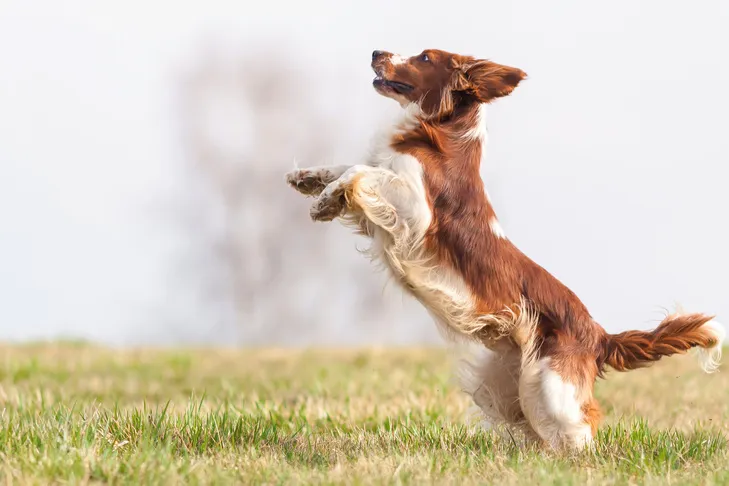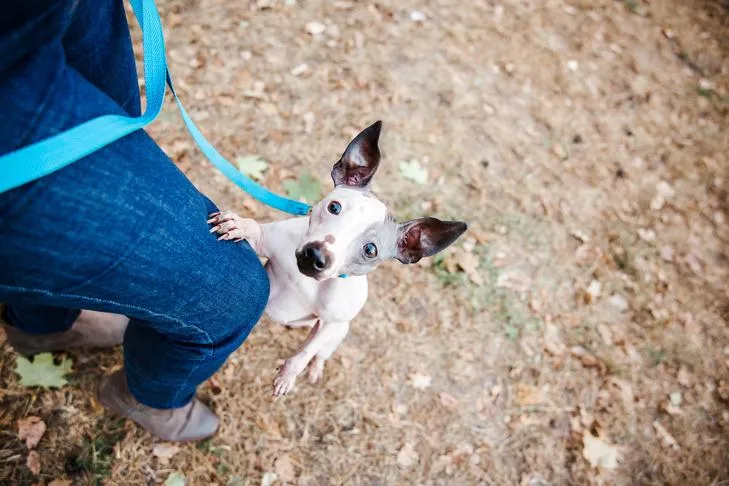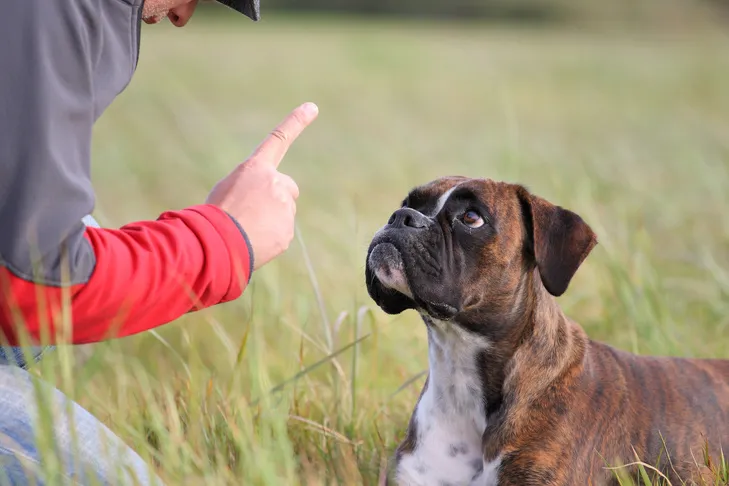Jumping up on people is a pervasive and often frustrating dog behavior problem that many owners face. While it’s your furry friend’s enthusiastic way of saying “hello” and seeking your attention, it can quickly become an unwelcome habit. For larger breeds, it poses a risk of knocking over children or seniors. Even smaller dogs can leave scratches or muddy paw prints on clothing. Understanding that jumping is a natural canine attempt to greet you face-to-face and an effective way to get noticed is the first step in addressing it. The key is to teach your dog an alternative, polite greeting rule, such as “keep your front paws on the floor.” This guide provides 10 actionable tips to help you teach your dog appropriate greeting behavior, ensuring they know exactly how to stop your dog from jumping on you when excited and greet humans respectfully.
1. Only Greet Your Dog When They Have Four Paws on the Floor
One of the most effective strategies for managing unwanted behaviors is to teach your dog an incompatible alternative. This means clearly showing them what to do instead of merely correcting what not to do. In the context of jumping, this could involve training your dog to keep all four paws firmly on the ground when greeting, as they cannot jump and stand simultaneously. Alternatively, you might prefer them to sit or lie down for greetings. Whatever specific rule you choose, consistency is paramount. Make it a strict policy to only acknowledge and give attention to your dog when they are following this chosen rule. This consistency helps them understand the clear boundaries you’re setting, preventing confusion and accelerating their learning process.
2. Give Attention As Soon As Your Dog’s Front Feet Hit the Floor
Dogs are intelligent creatures who quickly learn to repeat behaviors that yield desired outcomes. Therefore, positive reinforcement is crucial in shaping their greeting habits. The moment your dog complies with your greeting rule—for example, by keeping all four feet on the floor—immediately reward them with praise and gentle petting. Your attention is a powerful motivator for your dog, so ensure they receive this “reward” instantly when they perform the correct behavior, especially during the initial learning stages. Avoid any delays in your greeting, such as waiting to remove your coat or shoes, as your dog might become impatient and revert to jumping to gain your notice. Immediate positive feedback reinforces the desired behavior effectively.
3. Remove Attention When Your Dog Jumps
Conversely, to effectively curb jumping behavior, you must eliminate any reinforcement for it. Never reward a behavior you wish to extinguish. If your dog jumps on you, swiftly withdraw what they seek—your attention. This can be achieved by calmly turning your back or walking away from them. This action teaches your dog that jumping has the exact opposite effect of what they intended. The instant your dog places all four paws back on the floor, turn back around and offer quiet praise and petting. This creates a clear cause-and-effect relationship, helping your dog understand that their behavior acts as a switch, turning your attention on and off.
 Welsh Springer Spaniel jumping up on a person outdoors.
Welsh Springer Spaniel jumping up on a person outdoors.
4. Set Up Your Dog for Success
While ignoring jumping and rewarding proper greetings is effective, it can be a trial-and-error process that might frustrate your dog. To make learning easier and more positive, proactively set your dog up for success. If your greeting rule is for them to sit, ask them to sit as soon as you enter the door. If “four on the floor” is your requirement, encourage them to remain standing calmly. A fantastic trick to prevent jumping is to scatter several high-value treats on the floor. Most dogs can’t resist free goodies, and they certainly cannot jump while sniffing and eating treats from the ground. Be quick to provide the food before your dog even has a chance to think about jumping, rewarding their “four on the floor” with both your attention and delicious treats. Your dog will quickly grasp your greeting rule, and you can gradually phase out the food rewards over time.
5. Always Reward Your Dog for Proper Greeting Behavior
Your dog will learn appropriate greeting behavior much faster and more reliably if their actions consistently and immediately affect your attention. When their front feet are on the floor, they gain your attention; when they jump, it disappears. This means you must always reward your dog when they follow your greeting rule. Even if you’re feeling frustrated, perhaps after enduring several minutes of persistent jumping, do not withhold your attention the moment their feet finally touch the floor. Inconsistency will confuse your dog and undermine the training. It’s crucial that the rule is enforced without exception, ensuring your dog understands the clear link between their desired behavior and receiving your positive attention. This unwavering consistency is vital for your dog to learn how to make dog stop jumping on you effectively and quickly.
6. Don’t Grab or Push Your Dog Away
It’s important to remember that your dog jumps primarily to gain your attention. Therefore, even a seemingly negative physical response, such as grabbing them, holding their paws, or pushing them away, still registers as a form of attention. This inadvertently rewards the jumping behavior. Instead of reducing the frequency, such actions can paradoxically lead to more persistent jumping in the long run. What’s worse, for many dogs, this kind of physical interaction can be misinterpreted as an invitation to engage in roughhouse play. They might return to jumping harder and more vigorously, believing it’s all part of an exciting game with you. Avoid physical corrections to prevent reinforcing the behavior and maintain a positive relationship with your dog.
 American Hairless Terrier jumping up on its owner's leg outdoors.
American Hairless Terrier jumping up on its owner's leg outdoors.
7. Don’t Put Your Knee Up When Your Dog Jumps
You might have encountered advice suggesting that raising your knee to block your dog’s chest when they jump will deter the behavior. However, as previously discussed, for some dogs with a more boisterous personality, this action can be misconstrued as attention or an invitation to a wrestling match, leading to the opposite of the intended effect. More significantly, for the majority of dogs, this physical confrontation can foster distrust and severely erode the human-canine bond. Your dog is merely attempting to say “hello,” and responding with what they perceive as punishment can be deeply damaging to their confidence and trust in you. Such methods can even cause physical injury to your dog. A fractured trust can pave the way for other behavioral problems, like a reluctance to come when called, making it harder to get dog to stop jumping on people.
8. Keep Greetings Low-Key While Your Dog Is Learning
Dogs experience intense joy and excitement when greeting their beloved owners, making it incredibly challenging for them to control their impulses. It demands a significant amount of emotional self-control for them to resist the natural urge to jump and instead adhere to a new, polite greeting rule. You can make this learning process much easier for your dog by keeping your greetings initially low-key. Dogs are highly attuned to human emotions; if you are overly excited and animated, they will mirror that heightened state. Instead, strive to remain calm and quiet when you first arrive, even when offering praise. As your dog begins to grasp the new behavior, you can gradually increase your enthusiasm bit by bit, matching their joy without triggering unwanted jumping.
9. Prevent Your Dog From Jumping on Guests
It’s not just you who can inadvertently reinforce your dog’s jumping behavior. Other family members, guests, and even strangers on the street can all contribute to this problem if not managed carefully. To effectively prevent this, employ management techniques such as keeping your dog on a leash when guests arrive, thereby restricting their ability to approach and jump. An even better approach is to train your dog to “go to their place,” such as a designated mat or bed, or to use crate training, placing them in their crate when visitors are at the door. You can also utilize baby gates to block access to the front hall, creating a physical barrier. This helps ensure that everyone understands how to get your dog to stop jumping on people consistently.
 Boxer dog laying down outdoors, being trained by a man.
Boxer dog laying down outdoors, being trained by a man.
10. Ask Guests and Strangers to Follow Your Greeting Rule
Don’t hesitate to clearly communicate your dog’s greeting rules to guests and even polite strangers. While your dog is still in the learning phase, explicitly ask people to completely ignore your dog until you give the green light. It’s often beneficial to avoid encounters with strangers altogether until your dog has fully mastered appropriate greetings with friends and family who you know will cooperate with your training methods. When encountering strangers, you can use a “watch me” cue to grab your dog’s attention, or distract them with a hand touch exercise or a favorite toy until the stranger has passed. This proactive approach reinforces consistent behavior and prevents setbacks in your training.
Learning How To Stop Your Dog From Jumping On You requires consistency, patience, and a clear understanding of canine behavior. By implementing these 10 tips, you can effectively teach your dog polite greeting manners, transforming enthusiastic leaps into calm, respectful hellos. Remember, your dog is eager to please; it’s our job to guide them toward the right behavior. If you need expert advice from experienced trainers or have additional dog training questions, consider reaching out to reputable dog training services. AKC GoodDog! Helpline, for instance, offers personalized assistance for a wide range of training queries, from puppy basics to addressing unwanted behaviors in older dogs.
